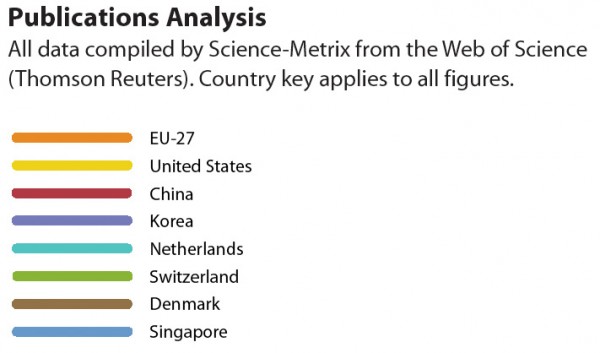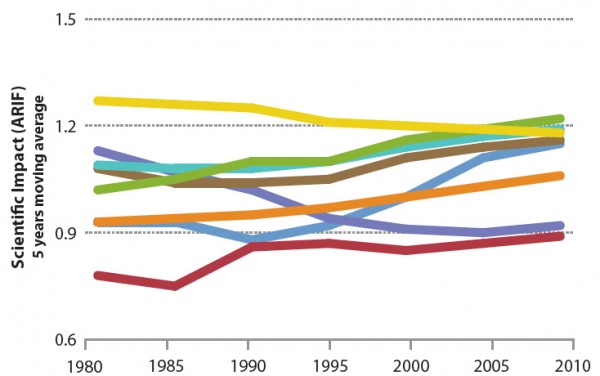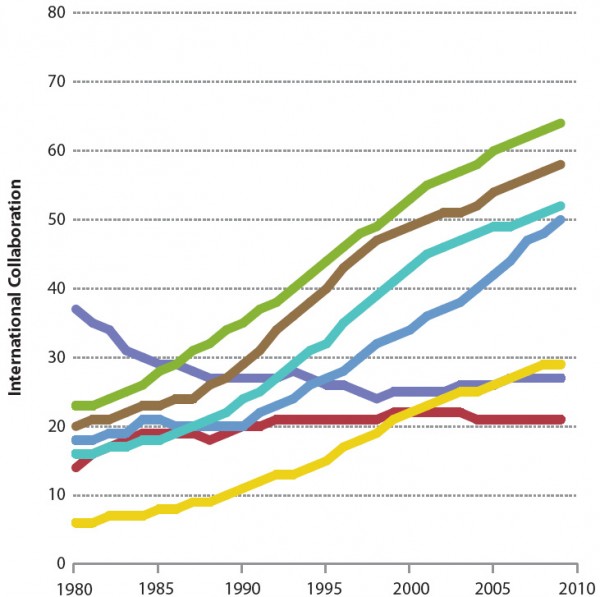The Shifting Landscape of Science
The days of overwhelming U.S. science dominance are over, but the country can actually benefit by learning to tap and build on the expanding wellspring of knowledge being generated in many countries.
Citations to U.S. science, in the aggregate, have been flat over the past 30 years, whereas citations of research papers from the rest of the world have been rising steadily. Although the relative decline in U.S. scientific prowess is perceived by many to be unalloyed bad news, the spectacular rise in scientific capacity around the world should be viewed as an opportunity. If the nation is willing to shift to a strategy of tapping global knowledge and integrating it into critical local know-how, it can continue to be a world research leader. Science is no longer a national race to the top of the heap; it is a collaborative venture into knowledge creation and diffusion.
We all know the story of the recent scientific past. Since the middle of the 20th century, the United States has led the world rankings in scientific research in terms of quantity and quality. U.S. output accounted for more than 20% of the world’s papers in 2009. U.S. research institutions have topped most lists of quality research institutions since 1950. The United States vastly outproduces most other countries or regions in patents filed. This privileged status was partly due to the historical anomaly at the end of World War II when the United States had a newly developed and expanding scientific system, whereas most of the rest of the industrialized world had to rebuild their war-torn science systems. The United States then capitalized on its advantage by rapidly expanding government support for research.
Many governments around the world, responding to the perceived significance of science to economic growth, have increased R&D spending. In 1990, six countries were responsible for 90% of R&D spending; by 2008, this number has grown to include 13 countries. According to the United Nations Educational, Scientific, and Cultural Organization (UNESCO), since the beginning of the 21st century, global spending on R&D has nearly doubled to almost a trillion dollars, accounting for 2% of the global domestic product. Developing countries have more than doubled their R&D spending during the same period.
The number of scientific papers worldwide has grown as R&D spending has increased. The number of scientific articles registered in the catalog services managed by Thomson-Reuters and Elsevier has increased from 1.1 million in 2002 to 1.6 million in 2007 (see Figure 1). And Thomson-Reuters indexes only about 5% of all scientific or technical publications, so there is much more science done and shared than what we can see in these numbers. The UNESCO report documents that the global population of researchers has increased from 5.7 million in 2002 to 7.1 million in 2007. The distribution of talent is spread more widely, and the quality of contributions from new entrants has increased.
FIGURE 1
Number of papers, 1980-2009
The number of papers has been computed using fractional counting at the level of addresses. For example, a paper with authors from two Canadian institutions and three U.S. institutions would register as 0.4 papers for Canada and 0.6 papers for the United States.
From 1980 to 2010, the growth in the output of scientific articles has resulted in a shift in the relative position of many countries. An explicit policy in the European Union countries plus Switzerland to close the quality gap with the United States has produced results as measured by citation counts. Switzerland surpassed the United States in citation quality measures in 1985, albeit based on a small number of publications, and Denmark, the Netherlands, Belgium, the United Kingdom, Germany, Sweden, and Austria have moved ahead of the United States in the past decade (see Figure 2).
Asia lags behind the United States and Europe in quality indicators of scientific output, though some of the gap might be explained by the fact that Asian journals are not well represented in the indexing services. Nevertheless, Singapore is leading an Asian surge in the rankings. If current trends continue, Singapore will rank fifth in the world in quality by 2015.
One explanation offered for the slide in the U.S. quality ranking is that a growing number of U.S. papers now include non-U.S. coauthors who share the credit for high-quality research. A second explanation is that the United States is producing output at a maximum level of efficiency, so that adding additional resources would not improve quality. A third is that other countries and regions have made a concerted effort to enhance the quality of their R&D, and they have seen good results. All three of these explanations may be factors.
As other parts of the world have enhanced their science bases, the U.S. percentage shares of all aspects of the knowledge system are giving way to a broader representation of countries. China and South Korea, two countries that are exponentially increasing their investment as well as the quantity and quality of their output, are rapidly taking leadership positions in scientific output. Between 1996 and 2008, the United States dropped 20% in relative terms in its share of global publications as other nations have increasingly placed quality scientific publications in journals cataloged by Thomson-Reuters and/or Elsevier.
The sustained rate of growth of China has caught the attention of many who track global science. Its rise may be due to the increasing availability of human capital at Chinese universities and research institutions. In addition, the Chinese Academy of Sciences is providing incentives for researchers to publish in cataloged journals. Chinese scientists who have been living abroad have been encouraged to return to China or to collaborate with their colleagues in China. These changes have increased the number of Chinese scientists who seek to publish in the cataloged journals, contributing to the growth in overall numbers in the Science Citation Index Expanded and the drop in percentage share of other leaders. At the same time that Asian countries have supported exponential growth in scientific publications, the United States and other scientifically advanced countries have maintained slow growth.
To view the relative position of national outputs in a way that normalizes for size of the workforce and the disciplines’ propensity to publish and cite, Eric Archambault and Gregoire Coté of Science-Metrix calculated the average of relative citations (ARC) by paper and by address of each author across 30 years of publication data (see Figure 3). The Science-Metrix ARC index is obtained by counting the number of citations received by each paper during the year in which the paper is published and for the two subsequent years. To account for different citation patterns across fields and subfields of science (for example, there are more citations in biomedical research than in mathematics), each paper’s citation count is divided by the average number of citations in that field. In other words, the calculation provides the average citation rate of papers in that same field during the same time period. An ARC value above 1.0 means that a country’s publications are cited more than the world average, and below 1.0, less than average. Counts are aggregated from the paper level by field up to the country level.
FIGURE 4
International collaboration, 1980-2009
Note: The percentage of international collaboration is calculated by dividing the number of papers co-authored with at least one foreign institution by the total number of papers.
The policy challenge
More knowledge worldwide can be a net gain for the United States. Gathered from afar and reintegrated locally, knowledge developed elsewhere can be tapped to stoke U.S. innovation. Despite this fact, the shifts in the global science and technology (S&T) landscape have been viewed with alarm by many U.S. observers. A number of groups have expressed concern that the rise of foreign capacity could undermine U.S. economic competitiveness. The 2010 update of the National Academy of Sciences’ Rising Above the Gathering Storm report observed that “the unanimous view of the committee members . . . is that our nation’s outlook has worsened” since the first report was issued in 2005, due in part to the rising scientific profile of many other countries. This reflects a nation-centered view of science unaware of the global dynamic of collaboration and knowledge exchange that characterizes science now.
As new researchers and new knowledge creators arise around the globe, those people, centers, and places that are in a position to access and absorb information will benefit. Unlike some economic resources, such as factories or commodities, knowledge is what economists call non-rivalous because its consumption or use does not reduce its availability or usefulness to others. In fact, scientific knowledge increases in value as it is used, just as some technologies become more valuable through the network effect as more people adopt them.
As centers of excellence emerge in new places, the United States can enhance efficiency through collaboration. This already takes place in some fields such as astrophysics and climate science, where the cost to any one nation of investing in S&T is too great. A more aggressive strategy of collaboration and networking can draw in knowledge in ways that free up U.S. scientists to produce more specialized or cutting-edge work. This could leverage investments at the national level to focus on more critical capacity-building, an approach called global knowledge sourcing. In business parlance, global knowledge sourcing means the integration and coordination of common materials, processes, designs, technologies, and suppliers across worldwide operating locations. Applying a similar vision to national-level investments could result in significant efficiencies for the United States at a time when budget cuts are pressuring R&D budgets.
Although the U.S. research system remains the world’s largest and among the best, it is clear that a new era is rapidly emerging. With preparation and strategic policymaking, the United States can use these changes to its advantage. Because the U.S. research output is among the least internationalized in the world, it has enormous potential to expand its effectiveness and productivity through cooperation with scientists in other countries.
Only about 6% of U.S. federal R&D spending goes to international collaboration. This could be increased by pursuing a number of opportunities: from large planned and targeted research projects to small investigator-initiated efforts and from work in centralized locations such as the Large Hadron Collider in Geneva to virtual collaborations organized through the Internet. Most federal research support is aimed at work done by U.S. scientists at U.S. facilities under the assumption that this is the best way to ensure that the benefits of the research are reaped at home. But expanded participation in international efforts could make it possible for the United States to benefit from research funded and performed elsewhere.
U.S. policy currently lacks a strategy for encouraging and using global knowledge sourcing. Up until now, the size of the U.S. system has enabled it to thrive in relative isolation. Meanwhile, smaller scientifically advanced nations such as the Netherlands, Denmark, and Switzerland have been forced by budgetary realities to seek collaborative opportunities and to update policies. These nations have made strategic decisions to fund excellence in selected fields and to collaborate in others. This may account in part for the rise in their quality measures. An explicit U.S. strategy of global knowledge sourcing and collaboration would require restructuring of S&T policy to identify those areas where linking globally makes the most sense. The initial steps in that direction would include creating a government program to identify and track centers of research excellence around the globe, paying attention to science funding priorities in other countries so that U.S. spending avoids duplication and takes advantage of synergies, and supporting more research in which U.S. scientists work in collaboration with researchers in other countries.
One recent example of movement in the direction of global knowledge sourcing is the U.S. government participation with other governments in the Interdisciplinary Program on Application Software toward Exascale Computing for Global Scale Issues. After the 2008 Group of 8 meeting of research directors in Kyoto, an agreement was reached to initiate a pilot collaboration in multilateral research. The participating agencies are the U.S. National Science Foundation, the Canadian National Sciences and Engineering Research Council, the French Agence Nationale de la Recherche, the German Deutsche Forschungsgemeinschaft, the Japan Society for the Promotion of Science, the Russian Foundation for Basic Research, and the United Kingdom Research Councils. These agencies will support competitive grants for collaborative research projects that are composed of researchers from at least three of the partner countries, a model similar to the one used by the European Commission. Proposals will be jointly reviewed by the participating funding organizations, and successful projects are required to demonstrate added value through multilateral collaboration. Support for U.S.-based researchers will be provided through awards made by the National Science Foundation. It would be useful to begin discussions about the metrics of success of these types of activities.
Tapping the best and brightest minds in S&T and gathering the most useful information anywhere in the world would greatly serve the economy and social welfare. Looking for the opportunity to collaborate with the best place in any field is prudent, since the expansion of research capacity around the globe seems likely to continue and it is extremely unlikely that the United States will dramatically increase its research funding and regain its dominance. Moreover, it may be that the marginal benefit of additional domestic research spending is not as great as the potential of tapping talent around the world. Thus, seeking and integrating knowledge from elsewhere is a very rational and efficient strategy, requiring global engagement and an accompanying shift in culture. Leadership at the policy level is needed to speed this cultural shift from a national to a global focus.





